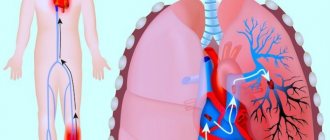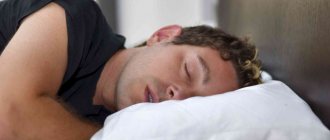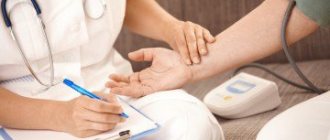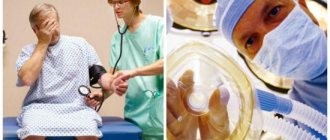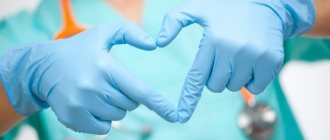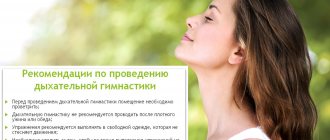What is respiratory arrhythmia
Respiratory arrhythmia (RA) is a phenomenon in which the pulse rate changes in a special way. As you inhale, it speeds up, and as you exhale, it slows down. This feature of the body often accompanies vegetative-vascular dystonia, but if there are no other signs of cardiac pathologies, it can be considered the norm.
In adult patients, the occurrence of cardiac respiratory arrhythmia is rare and is an alarming signal. It is necessary to visit a doctor and conduct an appropriate examination. SDA can be the result of diseases that have not yet been diagnosed.
The violation is classified into the following forms:
- Congenital. A failure caused by one reason or another during intrauterine development leads to the development of DA even before birth.
- Acquired. Disorders resulting from aging or third-party diseases.
Attention! There is an assumption, based on observations, that seven-month-old children are prone to respiratory arrhythmia.
Breathing exercises for cardiac arrhythmia
Few people know that breathing exercises for cardiac arrhythmia can work wonders. The result of correct execution is filling the body with oxygen, normalizing blood pressure and heart rate (HR). Breathing exercises are accessible cardio workouts that do not require any auxiliary elements. The exercises are very convenient, and the results are noticeable very quickly.
How dangerous is SDA?
SDA associated with respiratory phases does not pose a health hazard. This feature of the heart, most often, is not a disease. With DA, the physiological frequency of contractions is maintained, there are no interruptions in blood circulation, pain or swelling in the heart. Impulses, forming in the sinus node, disperse throughout the heart muscle without pathologies. If the tone of the nervous system is normalized, the heart rhythm evens out without any consequences.
Concern is justified if there is discomfort or pain in the heart. Of particular concern is respiratory arrhythmia, recorded on the ECG.
The appearance of SA can be observed after myocardial infarction, infections, and rheumatic carditis. With certain heart diseases, diabetes mellitus, arrhythmia disappears - with congenital defects, circulatory disorders, myocardial inflammation.
Diagnostics
If respiratory arrhythmia practically does not manifest itself symptomatically, it is clearly visible on the ECG. Ultrasound examination of the work of the heart muscle is considered no less informative. But ultrasound is often prescribed additionally only to clarify and make a diagnosis, which is manifested by cardiac arrhythmia. You should immediately begin treatment that causes such a disruption in the rhythm, because the disease can progress and cause more serious complications.
If necessary, the patient may be prescribed 24-hour Holter monitoring. Only a doctor can make an accurate diagnosis and decide whether the patient needs any treatment or whether it will be enough to be under the supervision of specialists.
In recent years, all babies are prescribed an ultrasound at the age of one month. In this way, it is possible to recognize serious diseases at the stage of their development, which helps to speed up recovery and provide medical care.
No matter how strange it may sound, this type of arrhythmia may indicate that the patient is getting better after suffering illnesses. For example, after rheumatic carditis or myocardial infarction.
What it looks like on an ECG
An electrocardiogram can not only diagnose SDA, but also distinguish it from “non-respiratory” arrhythmia. If the heart rate is not related to the phases of breathing, then it is simply sinus arrhythmia.
SDA is determined after deciphering the recorded electrical impulses generated by the cardiac system. Characteristics:
- ventricular complexes are preserved;
- the intervals between ventricular complexes at the peaks of inhalation and exhalation change;
- there is a change in the configuration of the P-wave;
- the intervals separating heartbeats have different lengths;
- PQ distance is normal all the time.
Respiratory sinus arrhythmia can be detected on an ECG only with deep inhalation/exhalation.
Decoding of electrocardiogram indicators:
- P - describes the activity of the atria. For a healthy person, the norm is 0.1 second. If this indicator deviates, there is a possibility of atrial hypertrophy.
- QT – characterizes the conduction of an impulse along the fibers. Normally it is 0.45 seconds. If there are deviations, cardiac ischemia, hypoxia, and arrhythmia are possible.
- РQ – atrioventricular conduction time. Normally – 0.12-0.2 seconds.
- RR is the interval between the upper parts of the ventricles, showing the regularity of the rhythm.
- QRS – ventricular complex. The norm is -0.06-0.1 seconds.
Special breathing exercises for arrhythmia
The development of heart disease often causes circulatory problems. Breathing exercises help improve lung function, resulting in normal heart rate. It is recommended to do gymnastics 2 times a day - in the morning and evening hours. The workout looks like this:
- They start with a warm-up. They take frequent breaths and exhales, and gradually begin to walk in place. It is important to remember: one step - one breath.
- They stand up, arms down along the body and relaxed. Inhale loudly and clench your fingers into a fist; as you exhale, relax your fist. Do 5-6 repetitions with a rest of 20-30 seconds.
- They stand up, hands on the belt, fingers in fists. A sharp inhalation and fists relax, the arms are lowered along the body, and when exhaling, they return to the original stance. Should be done 12 times with a minimum break of 5 seconds.
- Feet are shoulder-width apart, arms along the body. When inhaling, bend your whole body forward and extend your arms. When exhaling, they return to their original position. The exercise is done 12 times with breaks of a few seconds.
Read also: Arrhythmia in the evening
Among breathing techniques, Buteyko gymnastics has gained enormous popularity all over the world. It helps well with atrial fibrillation. A set of breathing exercises according to Buteyko looks like this:
- Inhale through your nose (it lasts 5 seconds), without straining your abs, hold your breath for a few seconds and exhale. Do 10 approaches.
- Take a deep breath through your nose for 9 seconds to fill the diaphragm and chest with air. They exhale. Do 11 approaches, with a 5-second break between them. During these 5 seconds of rest, massage the bridge of the nose.
- The next stage is nostril breathing. First, breathe through one nostril 10 times, then the same number through the other nostril.
- Take a deep breath, sucking in your stomach, and hold your breath for 8 seconds.
- Take 12 breaths per minute, each lasting at least 2 seconds.
- Restore breathing.
Respiratory arrhythmia during pregnancy
SDA can accompany pregnancy. When a woman is pregnant, her body experiences great stress. Pregnant women gain weight, which negatively affects cardiac activity.
If a woman did not experience arrhythmias before pregnancy, then after the birth of the child all symptoms disappear.
Pregnant women, instead of taking medications, are recommended to follow a number of rules to prevent SDA:
- Keep your weight normal. You can’t gain more than 300 g in a week.
- Engage in physical activity. Swimming, walking, and yoga are recommended.
- It is necessary to introduce foods rich in vitamins and microelements into the diet.
- To prevent blood pressure surges, it is necessary to limit the consumption of tea and coffee, salty and fried foods, and baked goods.
In severe cases, treatment is selected extremely carefully so as not to harm the unborn child.
Attention! During pregnancy, the symptoms of SDA are not recommended to be eliminated with medication, since most drugs are contraindicated for pregnant women.
Breathing exercises for cardiac arrhythmia (Buteyko, Strelnikova methods)
Disturbances in cardiac function cause discomfort and pain, and often lead to angina attacks. To alleviate the condition, a patient with arrhythmia takes medications prescribed by a doctor, however, any potent drug has certain side effects, so their regular use also harms the body. Therefore, it is advisable to use other methods to help the tablets that help eliminate arrhythmia, for example, treating arrhythmia with breathing exercises.
Respiratory arrhythmia in children
The dependence of pulsation frequency on the phases of the respiratory cycle is especially common in children. Sinus respiratory arrhythmia is usually detected during medical examinations, since it does not cause any discomfort in children. Moreover, the presence of this arrhythmia is completely invisible to them.
In children of the perinatal period, heart rhythm disturbances, which are a type of DA, may be observed. Such arrhythmias are congenital.
Children develop DA more often than adults. Newborns and infants, as well as children 6-7 years old, are especially susceptible to it. In the first case, the anomaly is associated with the characteristics of the child’s body, in the second – with the intensive development of the heart and all organs. In adolescents, DA is caused by increased growth of the skeleton and muscular system.
Most often YES suffer from:
- premature babies;
- newborns with high intracranial pressure;
- overweight children;
- at the age of 6-10 years.
Breathing exercises for arrhythmia after exercise
If arrhythmia appears after physical activity, it is recommended to resort to breathing practices. Physical therapy is not only the prevention of diseases, but also prevents the development of complications. The complex includes the following exercises:
- Do a half-squat, stretching your right arm to the side, and with your left, close one nostril and take a slow breath. Then change hands and do the same exercise. The number of approaches should be determined by the doctor, focusing on the presence of high blood pressure, tachycardia, ventricular fibrillation and other causes. This exercise is not recommended for small children.
- Sit on a chair. You should hold one nostril with your hand near the bridge of your nose and begin to slowly inhale air, followed by a quick exhalation. The same thing then needs to be done with the other nostril.
- Slowly draw in a full breath of air and exhale it also slowly.
- Repeat the previous exercise, simultaneously stretching your lips with a tube.
When this exercise is performed correctly, the blood is enriched with oxygen, and with it all the tissues of the body. When performing these exercises, the patient himself controls his breathing and the movements of the diaphragm.
Risk group
In addition to children and pregnant women, the risk group includes adults with certain problems or lifestyle characteristics.
The development of SDA is most likely:
- After illnesses. The anomaly is often observed after intoxication, infections, myocardial infarction and rheumatic carditis.
- When taking medications.
- During fasting or physical exhaustion of the body.
- With many years of smoking.
- For chronic stress.
In old age, respiratory arrhythmia can be observed with:
- heart defects;
- obesity;
- neurocirculatory dystonia;
- coronary heart disease;
- hypertension.
Treatment of pathology
If a rhythm disturbance is detected only on an ECG, then no special treatment is required. For neurocirculatory dystonia, predominantly non-drug methods of therapy are used:
- hardening,
- walk outdoors,
- therapeutic baths and showers,
- breathing exercises,
- physiotherapy,
- massage of the cervical-collar area.
In case of increased irritability or sleep disturbances, it is recommended to take plant-based sedatives before bed - tinctures of hawthorn, valerian, Persen, Fitosed.
Herbal teas with mint, lemon balm and chamomile are also beneficial. If there is no allergy, add a teaspoon of honey.
Causes
In the brain, two centers are located not far from each other - the respiratory and vagus nerves. They mutually influence each other.
For stress:
- breathing quickens;
- breaths become shallow;
- pulse quickens.
When relaxing, the opposite effects are observed. Meditation is based on this feature - stretching exhalations causes relaxation and a slowdown in heart rate.
In children and adolescents, SDA may be associated with imperfections in the regulatory mechanisms of the cardiovascular system. Pathologies often occur when:
- prematurity;
- cardiopathy;
- encephalopathy.
In adults, symptoms of DA may occur due to:
- traumatic brain injury;
- myocardial ischemia;
- stress;
- overwork;
- overstrain - mental or physical;
- smoking;
- fever;
- vegetative-vascular dystonia;
- overheating or hypothermia;
- disturbances in the synthesis of thyroid hormones - hyper- and hypothyroidism.
The mechanism of pathology development
Heart rhythm disturbances lead to changes in muscle contractions, as a result of which they deviate from the norm to a greater or lesser extent.
Negative changes are provoked by various factors, the most important of which is the state of the autonomic (peripheral) nerves, represented by sympathetic fibers and the vagus nerve.
The direct connection between cardiac activity and breathing becomes a consequence of the manifestation of respiratory arrhythmia.
Timely detection of a pathological condition becomes the key to preventing serious consequences.
Main symptoms
SDA is usually asymptomatic. Its presence will be known after an ECG is taken. Symptoms depend on age. In children, SDA may be accompanied by the following symptoms:
- suffocation;
- blue discoloration of the nasolabial triangle;
- shortness of breath even with light exertion;
- irregular pulsations in the wrist;
- periodic pain in the left side of the chest.
With age, symptoms of DA are associated with vegetative-vascular dystonia. Patients may experience:
- irregular heartbeat;
- heart sinking;
- sweating of the feet and palms;
- dizziness;
- cold extremities;
- suffocation.
On a note! Although SDA is accompanied by a variety of symptoms, it itself is manifested only by an increase in heart rate.
What is pathology? Definition and essence of the medical term, pathogenesis
According to the World Health Organization definition, arrhythmia is any deviation of the heart rhythm from normal sinus contraction associated with a dysfunction in the generation/distribution of an electrical impulse. Thus, the definition of arrhythmia includes any disturbance in the frequency, rhythm or process of excitation and contraction of the heart muscle.
There are several types of arrhythmia (physiological tachycardia, sinus-type tachycardia, sinus-type bradycardia, paroxysmal tachycardia, extrasystole), each of which can be provoked by external or internal phenomena/processes/pathologies.
The term “respiratory arrhythmia” is used when drawing up a diagnostic report after an examination.
Important!
Respiratory arrhythmia is not a disease, and solely symptomatic therapy is considered inappropriate. Respiratory arrhythmia is a symptom accompanying the underlying disease, which must be differentiated based on an additional highly specialized diagnostic examination.
Diagnostic methods
Diagnosis begins with an examination. A doctor may observe increased sweating, hand tremors, and pale skin in a patient with SDA. An asthenic physique is also common among people with respiratory arrhythmia. The goal of further research is to exclude pathologies that are accompanied by an unstable pulse. SDA has no obvious symptoms, but it can be easily diagnosed by doing an ECG or ultrasound. Based on the research results, an experienced doctor can easily diagnose the deviation.
Diagnostic methods:
- Auscultation. When listening, the heart sounds are unchanged, there are no pathological noises. Changes in the rhythm of contractions are heard at different stages of the respiratory cycle.
- ECG. On an electrocardiogram, an abnormality is obvious to a cardiologist. Only with arrhythmia in the sinus node is there a difference in the duration of the intervals.
- Ultrasound. This test is performed to rule out heart disease. With SDA, there is no deviation in the hemodynamics of the internal functioning of the heart.
- Holter device. The patient wears a portable device that records heart function for 24 hours. The examination is prescribed for adult patients with concomitant diseases of the cardiovascular system.
- Echocardiography. Explores the functioning of the heart and its structures. Prescribed to patients with valve defects or heart failure.
- Orthostatic test. It is used to evaluate the regulation of the peripheral circulatory system. The patient's pulse and blood pressure are measured in a supine position. After this, the patient rises, and the readings are recorded again. Then pulse and blood pressure are measured again. If the body is healthy, then hemodynamic parameters practically do not change during testing.
- Blood tests. All age indicators are within normal limits.
Breathing exercises according to Strelnikova
Therapeutic breathing for the heart during arrhythmia, primarily in unadvanced cases, can be effective, especially using the Strelnikova method. With its help, it is possible to significantly improve blood supply to the heart and activate blood oxygenation in the lungs.
Recommendations for implementation
- The main highlight of Strelnikova’s method is strong and sharp breaths taken through the nose. You can exhale arbitrarily, but it is better to do it through your mouth.
- This complex should begin with three exercises repeated twice a day, and one exercise should be added daily.
- Instead of 3-5 seconds of rest between actions, you can initially take 10 seconds.
- Classes should not last more than half an hour.
- Strelnikova herself recommends doing her exercises every day, 2 times a day, for the rest of her life.
Initial exercises
"Palms"
You need to stand up straight and bend your arms at the elbows, turning your palms forward. Taking 4 rhythmic breaths in a row through your nose, clench your palms into fists. Slowly lowering your arms and exhaling freely through your mouth, rest for 4 seconds. In any position (standing, sitting or lying down) do 24 approaches. If it becomes difficult, the duration of rest can be increased to 10 seconds.
"Epaulettes"
Stand up straight, press your hands to your stomach with clenched fists. As you inhale, sharply push your fists down, simultaneously straining your shoulders. Then, as you exhale, return your arms to waist level and relax your shoulders. After taking 8 breaths, pause for 4 seconds. (12x8).
"Pump"
This exercise, which trains breathing during cardiac arrhythmia, also begins in a standing position, your legs should be spread wider than your shoulders, and your arms should be lowered along the body. Bend slightly forward, lowering your head and rounding your back, stretch your arms towards the floor, but do not touch it. Inhale while bending over. During exhalation, you do not need to straighten up completely. Do bends at a frequency of 100 times per minute (12x8). If a person has had head or back injuries, he should not bend over too much.
Using the “pump” exercise, you can quickly relieve an arrhythmic attack, but under no circumstances should you lean back.
"Cat"
Starting position: standing with legs almost closed. This is followed by a small squat with a turn to the right and a simultaneous sharp inhalation. This is followed by a return to the starting position and the same exercise with a turn to the left. The knees bend only slightly, and you need to make grasping movements with your hands. The back remains straight, and the rotation is carried out at the expense of the waist. (12x8).
"Hug Shoulders"
Bend your elbows while standing and raise them to shoulder level. While inhaling sharply, hug yourself by the shoulders without crossing your arms (12x8). If the exercise is difficult, then it is enough to do 4 approaches.
"Big Pendulum"
Stand up straight with your feet apart, narrower than your shoulders. Inhaling, lean forward and stretch your arms to the floor. When straightening, hug your shoulders with your arms, inhaling again (12x8). The exercise can also be done while sitting. If you have problems with your spine, you should not bend.
Video with breathing exercises performed according to Strelnikova:
Read also: How to replace digoxin for arrhythmia
Recommended completion schedule:
- Each exercise must be performed while inhaling, dividing it into eight parts and doing 12 such approaches. As a result, each exercise will result in 96 shallow breaths. This should be the program for the first day of preventive gymnastics.
- The next day, for each exercise, instead of 8 breaths, you need to take 16 and do 6 repetitions.
- After another couple of days, the number of breaths per exercise should be increased to 32, but three such approaches should be left. As a result, the total number of breaths will remain the same (96), but the intensity of the breathing training will increase.
Subsequent exercises
When Strelnikova’s breathing exercises for cardiac arrhythmia in the form of these first 6 exercises are mastered, then you can then add one new exercise per day to them.
"Head turns"
Standing position, legs narrower than shoulders. When inhaling, turn your head to the right, when returning to the starting position - exhale, the next time you turn to the left - inhale again. (12x8).
"Ears"
The starting position is the same. Tilt your head to the right, reaching your shoulder with your ear and inhaling, returning your head to its original state, exhale, and when tilting to the left, inhale again. (12x8).
"Pendulum head"
The starting position is the same. When inhaling, tilt your head forward, looking at the floor, exhale when returning to the starting position, and when tilting your head back (look up), inhale again. (12x8). For pathologies of the cervical spine and head injuries, as well as epilepsy, in exercises 7-9 you need to inhale sharply, but do not complete the movements.
Stand with your left leg forward and your right leg back. Transfer your body weight to your left leg, while bending your right leg and placing it on your toe. While inhaling strongly, squat on your left leg. Having straightened it, transfer the weight of the body to the right leg. Inhaling, squat on your right leg. (12x8).
"Steps" ("rock and roll")
A regular stance with your feet narrower than your shoulders. Raise your left leg to the level of your stomach, bending it at the knee and pulling your toe down. Taking a noisy breath, squat on your right leg. Return to starting position. Similarly with the other leg (8x8).
Bend your left leg at the knee, bringing your heel to your buttock. Inhaling, squat on your right leg. Do the same with the other leg. (4x8). If you have heart disease, thrombophlebitis, or injuries to the limbs, raise your legs low, and take 10-second pauses between approaches.
Recommended exercise schedule:
- The first four of these exercises should be introduced according to a similar scheme, only start with 8 sets of 12 breaths per movement and with pauses between movements of 5 seconds.
- In subsequent days, increase the number of breaths while reducing repetitions.
You should perform the last two exercises very carefully, as they put a serious strain on the heart. They can be started only when all previous exercises have been fully mastered. It usually takes a week before increasing the intensity.
Treatment
Treatment regimens for SDA are developed individually for each patient. Quite often, doctors define the diagnosis as normal and does not require any treatment. But even in this case, one cannot completely forget about the anomaly; observation by a cardiologist is necessary.
The health status of children with sinus DA is especially carefully monitored. All patients diagnosed with SA, regardless of age, are advised to lead a healthy lifestyle.
The main goal of treatment is to restore normal heart rate and normalize daily life.
Children
Parents should understand that a child with sinus DA is not sick. He can go not only to school, but also to a variety of extra classes and clubs. If during extracurricular activities respiratory arrhythmia intensifies, you will have to slow down the pace of classes, normalize the regime and rest more.
In childhood and young adulthood, SDA is considered normal, unless it is hiding another, more serious disease. Therefore, if a respiratory arrhythmia is detected, a thorough examination is necessary.
Pregnant
Most medications are contraindicated for pregnant women. Moreover, there is no need for drug treatment for SDA. It is necessary to normalize your diet, walking schedule and regularly see your doctor.
If a pregnant woman has any pathology related to the work of the heart, she is treated in a gentle manner. The treatment regimen is developed individually.
Attention! If there are no pathologies from various organs and systems, with sinus DA, delivery occurs naturally.
Adults
In adults, the presence of SDA can no longer be perceived as the norm. It is necessary to find the cause of the heart rhythm disturbance. If the primary pathology is eliminated, then the respiratory arrhythmia will immediately go away.
Treatment for sinus DA depends on the disease that causes it. They treat not the arrhythmia itself, but the pathology that caused it:
- Organic heart damage. The primary disease is treated with medication. Beta blockers and other antiarrhythmic drugs may also be prescribed.
- Nervous system disorders. If SDA is associated with prolonged emotional overstrain or prolonged stress, the patient is prescribed sedatives. Initially, herbal medicines are prescribed. The most popular drugs are Novo-passit, motherwort tincture, and valerian. It is recommended to drink tea with mint, chamomile or linden, milk with honey. Aromatherapy procedures are also useful. Consultations with a neurologist followed by drug treatment are rarely necessary.
If the respiratory arrhythmia does not cause any health problems and has no pathological underlying causes, no specific treatment is required.
For SDA it is recommended:
- magnetic physiotherapy;
- acupuncture;
- breathing exercises by Strelnikova or Fokin.
You can take vitamins, drugs to normalize sleep, restorative and immunomodulating agents.
Today there are many drugs used to treat arrhythmias. Some are prescribed in emergency cases, others are drunk by chickens. But there are new drugs that have a wide range of mechanical effects.
The latest drugs used for arrhythmias:
- Triplix. Normalizes blood pressure. Diuretic, ACE inhibitor.
- Methonate. Normalizes cardiac activity, saturating cells with oxygen. Improves myocardial contractility. Taking the drug makes it easier for patients to tolerate physical activity.
- Quinidine. An antiarrhythmic drug that keeps the heart rate within normal limits.
- Mexiletine. Reduces repolarization time, which allows you to quickly restore heart rhythm.
To relieve symptoms of respiratory arrhythmia, you can use folk remedies:
- 1 tsp. pour a glass of boiling water over calendula flowers. Leave for one hour. Strain and take 100 ml 3 times a day.
- 1 tsp. pour a glass of boiling water over the mint and wrap it up. After half an hour, strain. Drink the prepared tea throughout the day. Prepare mint infusion every day. Course – 1 year.
- Eat 50 g of natural honey daily. It improves well-being, increases hemoglobin, strengthens the heart muscle and blood vessels.
In 90% of cases of SDA, the heart rhythm returns to normal without drug intervention. And only 10% require medical supervision and certain therapy.
Treatment and prevention
No specific treatment is required for this disease unless there are any complications.
First of all, in the case of respiratory arrhythmia, you should normalize your lifestyle : sleep longer, eat right, and do not overexert yourself. This is especially true for children: if a child attends a large number of clubs after school, but his body cannot cope with such increased loads, then it is worth giving up a number of extracurricular activities for the sake of the health of your child.
A large amount of salt in food also negatively affects the functioning of the cardiovascular system, so it is recommended to reduce salt intake per day to 1.5 g. Everyone knows that it is useful to drink a lot of fluid, especially for patients with respiratory arrhythmia (1.5-2 liters of water in a day).
Due to overstimulation of the nervous system in newborns and premature babies, it is important for mothers to use soothing herbal preparations that pass to the baby with mother’s milk, or to give babies soothing tea.
As a preventive measure, it is recommended to avoid heavy physical activity, stressful situations and perform useful breathing exercises.
Complications and prognosis
Heart rhythm disturbances in childhood and adolescence usually go away on their own, without leading to any consequences. In adults, complications depend on the severity of the problem.
One of the most common complications of sinus node arrhythmia is bradycardia. Its symptoms:
- the pulse slows down, becoming less than 60 beats per minute;
- blood pressure drops;
- performance decreases;
- There is constant fatigue and drowsiness.
There are 4 types of bradycardia:
- Absolute. With it, the heart rate is not affected by external influences and the state of the body.
- Relative. The rhythm is reduced due to a head injury, and in athletes due to heavy loads.
- Moderate. This type of bradycardia is most often observed with respiratory arrhythmia. It is especially common in children who are hypothermic or very frightened. Pulse irregularity is observed during deep breaths and during sleep.
- Extracardiac. Appears together with diseases of the kidneys and nervous system.
Moderate bradycardia is diagnosed extremely rarely, since it hardly manifests itself. When the heart rate drops to 40 beats per minute, dizziness, suffocation, and even fainting occur.
The prognosis for sinus DA is favorable. This condition is not dangerous to health. There are no serious complications or irreversible life-threatening consequences. Further developments depend on the presence of other diseases - how serious they are and whether their treatment is possible.
Features of physical activity for atrial fibrillation
With atrial fibrillation, physical activity is allowed if it occurs without organic changes in the myocardium and paroxysmal attacks, when rapid heart contractions suddenly begin and end. In this case, the following rules must be observed:
- do exercises from the category of recreational gymnastics, but sports training is strictly prohibited;
- do anaerobic exercises aimed at increasing the breathing rate and heart rate for a relatively long time (walking, swimming, running at a slow pace, cycling);
- The pulse rate should not be higher than 180 beats per minute minus the number of years;
- breathe through the nose, and breathing should not cause even the slightest difficulty;
- slowly and evenly increase the load.
Like any muscle, the heart is contraindicated both from inactivity and excessive tension, so moderate exercise is only welcome. So, for arrhythmia, it is recommended to engage in leisurely swimming, running and walking, squats, and cycling without extreme sports. However, before starting treatment of arrhythmia with physical exercises, be sure to consult with your doctor.
Treatment with folk remedies
Sinus respiratory arrhythmia, if it is not accompanied by concomitant diseases, rarely requires therapy. If attacks of arrhythmia are very disturbing, then you can take sedatives - Valerian, Persen, alcohol tincture of motherwort.
You can also turn to traditional medicine recipes to relieve symptoms:
- Pour 400 milliliters of boiling water over calendula flowers (2 teaspoons). Let the infusion stand for 60 minutes and after filtering, take 100 milliliters 3 times a day;
- mint infusion helps well in adolescence at the initial stage of arrhythmia development: 1 teaspoon per 200 milliliters of boiling water, wrap for 20 - 30 minutes. Drink the filtered solution one day before. Prepare a new one every day. The course of treatment with this drink is at least 12 calendar months;
- Eat 50 grams of natural honey every day. This will not only improve your well-being during arrhythmia, but also increase the hemoglobin index in the body and strengthen the heart muscle and blood vessels.
Symptoms
Symptoms of respiratory arrhythmia, sinus etiology, manifests itself in an increased heart rate during stress on the body, or during a period of nervous shock. This symptomatology is pronounced in children (especially often observed in obese children).
Sensations of respiratory arrhythmia:
- The heart organ begins to work unevenly;
- There is a feeling of freezing in the heart organ;
- Increased heart rate;
- Weakness of the whole body;
- Dizziness, sometimes severe;
- Fainting;
- Shortness of breath during physical activity and fast walking;
- Lack of air in the body.
Symptoms of respiratory arrhythmia are the same at any age.
This type, arrhythmia of the heartbeat, is often observed in women who are carrying a child.
Severe symptoms do not appear in pregnant women, since there are no clear symptoms of sinus respiratory arrhythmia in children.
Many people simply do not notice individual symptoms of heart muscle rhythm disturbances. Therefore, at the first symptoms of this disease, it is necessary to show the child to a cardiologist.
Although respiratory arrhythmia does not pose a danger to the heart and blood flow system, and does not provoke severe complications of these organs, it must be eliminated completely.
Forecast
Despite the frightening symptoms, respiratory arrhythmia is not life-threatening. This disorder does not progress and quite often goes away without a trace after some time without treatment. Nevertheless, a person must undergo a comprehensive examination to identify concomitant pathologies.
Respiratory arrhythmia in adults can be part of a symptom complex of various diseases and disorders, including:
- vegetative-vascular (neurocirculatory) dystonia;
- heart failure;
- cardiac ischemia;
- asthenic syndrome.
Quite often, this symptom appears in people prone to migraines and panic attacks. Only a doctor can accurately identify the causes of the disorder.
Diagnostic study
The diagnosis of sinus-type respiratory arrhythmia can be made by a cardiologist only after collecting an anamnesis and a comprehensive medical examination of the sick person. Taking an anamnesis is the initial determination of the diagnosis.
When taking an anamnesis, it is necessary to tell the doctor about the symptoms, as well as describe the full picture of the diseases suffered. It is important to inform your doctor about genetic hereditary diseases.
After the medical history, the doctor conducts auscultation and listens to the tone of the heart; it is also necessary to conduct a study of the cardiac organ using percussion, and determine the boundaries of the cardiac organ.
Diagnosis of respiratory arrhythmia
Respiratory arrhythmia is characterized by changes in the cardiac boundaries, which is the cause of this pathology.
The following methods are used for the examination:
- Blood test - general;
- Urine analysis - general;
- Biochemical laboratory analysis;
- Hormone level analysis;
- ECG method (electrocardiography);
- ECHO (echocardiography);
- Holter method for studying the disease;
- Ultrasound of internal organs.
Using an ECG, the doctor records the heartbeat, correct rhythm, and the functioning of the sinus node. Also, an ECG can be used to find out whether these symptoms are a more dangerous type of arrhythmia: extrasystolic or atrial fibrillation.
The cholera diagnostic method involves monitoring a sick person for 24 hours. This technique is carried out only within the walls of the hospital’s cardiology department.
In adolescents, an ECG is often taken before the test. Next, a second ECG procedure is performed with a load on the body (in the form of squats) and the frequency of pulsating contractions is recorded. Based on this result, the condition of the heart and vascular system is determined.
Based on biochemical analysis, possible causes of respiratory arrhythmia that have a non-cardiac etiology are identified.
Treatment methods
The manifestation of respiratory arrhythmia in adolescence and childhood is physiological in nature and does not require urgent medical attention. However, preventive measures help to avoid worsening respiratory arrhythmia and help eliminate the main symptoms.
Treatment methods after making a more precise diagnosis may differ slightly, but the main direction of treatment is to stabilize the patient’s psycho-emotional state and eliminate causes of nervous overload. Sufficient physical activity, positive emotions and regular preventive examinations with a cardiologist will allow you to timely identify the onset of pathology, begin its treatment and prevent the worsening of symptoms, which guarantees the elimination of possible complications.
To improve respiratory function and eliminate manifestations of arrhythmia that reduce the quality of daily life and can provoke further deterioration of the patient’s condition, you should follow the recommendations of a cardiologist. Typically, a doctor may recommend such remedies as preparations based on extracts of belladonna, valerian and motherwort, sedatives that eliminate nervousness and relieve stress. Psycho-emotional stress can also be relieved with the help of autogenic training.
Prevention
No special measures have been developed to prevent the development of respiratory arrhythmia. Recommendations for children are to be regularly monitored by a cardiologist so as not to miss more serious problems with the cardiovascular system, which initially cause the same symptoms.
To prevent respiratory arrhythmia, adults are advised to adhere to a healthy lifestyle:
- give up alcohol and smoking;
- eat rationally - women should give up “food swings” and unbalanced diets for weight loss;
- maintain physical activity, avoiding overwork;
- Avoid stress if possible.
Therapeutic effect
The functioning of the cardiovascular system depends on the oxygen content in the blood and the condition of the lungs. A strong increase in oxygen content in the blood activates processes in the cardiovascular system. Dilation of the coronary arteries and normalization of blood supply to the myocardium relieves an attack of arrhythmia and angina. Improving heart function and increased output allows you to get rid of swelling of the lower extremities and face when these phenomena are associated with heart failure. Allows you to eliminate congestion in the lungs.
Breathing techniques allow you to get rid of rhythm disturbances and tachycardia. Circulation in the brain improves. Due to the fact that the central nervous system is controlled, excessive irritability and anxiety are eliminated. During prolonged exhalation, blood vessels dilate and pressure in the vascular wall decreases. Thus, blood pressure reaches a normal level and remains for a long time.
Proper breathing leads to the disappearance of chronic fatigue and promotes increased activity and performance. Qigong and Taoist breathing techniques are especially good for arrhythmia. Although breathing is an activity performed automatically by our bodies, we can influence its effectiveness. Adequate breathing exercises ease the work of the heart and improve our well-being. Remember that for our nerve center it is not just air, but also support for basic functions!
Thanks to proper breathing, we provide our body with the oxygen necessary for the functioning of all tissues. Of particular importance here is brain tissue, which is sensitive to oxygen deficiency. Therefore, if you do not want a bad mood or constant headaches, do not forget about proper breathing exercises.
These techniques help us breathe deeply and harmoniously. Without them, we breathe only shallowly and uncoordinatedly, so we don't even use half of our lungs! Breathing exercises will change that!
They should be done immediately after waking up, as well as while walking or on the way from work.
Bad habits—hunched arms, tight chest—lead to shallow breathing. This provokes pain in the muscles, back and abdominal cavity. Such people usually breathe shallowly and quickly, using no more than one-third of their lung capacity.
When the techniques for arrhythmia are performed correctly, it is possible to get rid of excessive heartbeat; you can simultaneously add moderate physical activity, which is acceptable in the absence of complications. If coronary heart disease occurs, excess stress is unacceptable. It is advisable to do breathing exercises daily. Sometimes the patient is recommended to take medication if it turns out that lifestyle changes alone will not help.
Gymnastic exercises represent excessive physical activity for people with complex forms of disease. They are contraindicated for children and adults and when there are complications.
Exercises with heart disease must be approached very responsibly. Therapeutic exercise involves exercises with varying degrees of intensity. They have a strong positive effect if the disease is not accompanied by significant symptoms. A properly selected treatment regimen is an excellent means of preventing arrhythmia. Independent attempts at treatment and traditional medicine are unacceptable if a heart defect and other serious pathologies are detected. The examined patient is asked in detail about his state of health and those complexes that are poorly tolerated are eliminated. It is especially important to constantly monitor the condition in old age. The heart muscle will be supported by exercise if it does not cause fatigue and heart rhythm disturbances. The described options will be of unconditional benefit for VSD and other heart diseases of a functional nature.
By inhaling air, we deliver oxygen to the lungs, which enters the bloodstream. Exhalation is the removal of unnecessary carbon dioxide from our body.
At rest, a person breathes at a rate of 12-14 breaths per minute (20,000 breaths per day). With each breath, it introduces about 500 ml of air into the lungs, so it introduces 6 liters of air into the lungs within a minute.
The lungs have a huge reserve. During intense physical effort, about 2500-3000 ml of air can be introduced into them. In a healthy young person, the vital capacity of the lungs is about 4500-5000 ml; in women it is slightly less. About 1500 ml of air is constantly stored in the lungs, regardless of the phase of breathing. This means that the total lung volume is about 6000 ml.
The lung ensures the stability of the gas composition in the alveoli and makes the diffusion of gases for each of the sections in one direction: oxygen is sent in the form of bubbles into the blood and carbon dioxide is taken from the blood and removed to the outside.
A healthy person breathes spontaneously, but at the same time can influence the depth and frequency of breathing through laughter, singing and even yawning. The latter perfectly saturates the body with oxygen. Lung capacity also increases through movement: walking, running, dancing, cycling or gymnastics.
Good breathing starts from the diaphragm. The diaphragm is a muscle mass weighing almost 5 kg that separates the chest from the abdominal cavity. When you inhale and exhale air, the diaphragm contracts and moves downwards, leaving room for the expanding lungs. During exhalation, the abdominal muscles push the diaphragm into the lungs, allowing air to escape out. Deep diaphragmatic breathing increases the secretion of endorphins - the hormones of happiness.
Respiratory arrhythmia: causes, symptoms and ECG registration, treatment – is it required or not?
© Sazykina Oksana Yuryevna, cardiologist, especially for SosudInfo.ru (about the authors)
There is nothing permanent in the human body. Thus, important vital parameters may change over a short period of time, and this is normal. For example, breathing rate, temperature and other characteristics of the body change depending on the work of the body at one time or another. Heart rate is no exception.
In a healthy person, the heart contracts at a certain interval and with a frequency of beats per minute set at the genetic level. In adults, the normal heart rate is between 55 and 90 per minute, while in children it can reach 120 per minute.
In all age categories of healthy individuals, the heart rhythm is sinus and regular. This means that electrical impulses are born at the very beginning of the electrically conductive fibers of the heart - in the sinus node, from where the excitation spreads in a sequential way, stimulating regular contractions of the heart muscle.
With arrhythmia, the regularity of the heart rhythm is disrupted, and the muscle contracts more often or less frequently.
All the described processes occur throughout the life of the organism and are regulated by a number of neurohumoral factors.
One of them is the innervation of the heart by branches of the autonomic nerves - the vagus nerve and sympathetic fibers. It is this fact that explains the close relationship between the heartbeat and the act of breathing.
In addition, the occurrence of respiratory arrhythmia is due to the anatomical proximity of the lungs and heart.
change in RR intervals on the ECG during breathing
So, what happens with respiratory arrhythmia? This type of arrhythmia is not a heart rhythm disorder in the literal sense of the concept, since, firstly, in general, the heart rate (HR) remains within acceptable limits, and secondly, in the vast majority of cases, respiratory arrhythmia is not hemodynamically significant, that is, it does not lead to serious circulatory disorders in the body (a drop in blood pressure, shock, pulmonary edema, etc.).
Sinus respiratory arrhythmia, that is, emanating from the sinus node, is characterized by an increase in heart rate at the time of inspiration, especially deep, and a decrease in heart rate at the time of exhalation. This heart rhythm does not occur during every inhalation-exhalation cycle, although in some cases it can be constantly recorded in the patient.
Causes of respiratory arrhythmia
So how can we regard this type of arrhythmia - as a variant of the norm or as a pathology that needs to be treated? In most cases, a slight disturbance in the regularity of sinus rhythm caused by breathing is normal and does not require treatment. As a rule, arrhythmia during breathing occurs in children, adolescents and young adults.
In adults, respiratory arrhythmia occurs as a response of the heart to stress factors, physical activity, and also during prolonged physical or mental fatigue.
However, in the case when the patient has cardiac complaints, and the ECG may reveal other rhythm disturbances, the doctor should prescribe a dynamic ECG and additional examination methods.
This is due to the fact that with some pathology of the cardiovascular system, pronounced respiratory arrhythmia also develops. In particular, with myocardial ischemia, when ischemic zones appear in the area of the conduction system of the heart, a slight disruption of the sinus node is possible.
Although, of course, coronary disease is characterized by more serious rhythm disturbances.
In addition to the above reasons, respiratory arrhythmia occurs with vegetative-vascular dystonia, overheating and hypothermia of the body, during periods of high fever, as well as with diseases of the thyroid gland (hypo- and hyperthyroidism).
What symptoms does it present?
Typically, respiratory arrhythmia does not manifest itself clinically, but is detected only during an electrocardiogram.
However, some people, especially those with low body weight, may experience palpitations, a feeling that the heart is stopping or stopping.
In addition, autonomic disorders are possible - excessive sweating, cold sticky sweat, cold hands and feet. These symptoms are not so much a manifestation of respiratory arrhythmia as concomitant symptoms of vegetative-vascular dystonia.
Respiratory arrhythmia in children and adolescents can be caused by prematurity, congenital cardiomyopathy, rarely – congenital malformations, vegetative-vascular dystonia in older children, rapid growth of the body and the heart itself at the age of 6-7 years, and a hormonal surge during puberty. At the same time, it can manifest itself as shortness of breath with little physical exertion, a bluish coloration of the nasolabial triangle, a feeling of lack of air and an irregular pulse in the vessels of the wrist. Also, from time to time, the child may notice painful sensations in the left half of the chest. As a rule, such discomfort occurs in older children. In the smallest children - infants - arrhythmia manifests itself only as an irregular heartbeat depending on the phases of inhalation and exhalation.
Again, in children, as in adults, the described clinical manifestations occur extremely rarely, and in most cases there are no symptoms of respiratory arrhythmia.
How is respiratory arrhythmia detected?
The most reliable and fastest diagnostic method is an ECG, which is prescribed to a child at the age of one month, followed by once a year for healthy children.
Changes in contraction frequency depending on inhalation (green) and exhalation (orange) during a breathing test
If the pediatrician, along with respiratory arrhythmia in a child, has detected a heart murmur, growth retardation, cyanosis of the nasolabial triangle (blue color), and also suspects other rhythm disturbances, he will prescribe additional research methods, in particular, daily ECG monitoring and ultrasound hearts.
In recent years, ultrasound of the heart has been performed as part of medical examination for all babies at the age of one month, therefore, if ultrasound does not diagnose a heart defect or other gross organic pathology, and respiratory arrhythmia persists, parents can calm down and not panic due to the presence of arrhythmia.
However, even in cases where parents are confident that their child is completely healthy, but respiratory arrhythmia has been detected, it is still advisable to visit a pediatrician to conduct an ultrasound of the heart and rule out more serious pathologies.
For adults with respiratory arrhythmia, an ECG should be performed on every professional. inspection, but at least once a year. Patients with respiratory arrhythmia may also be prescribed cardiac ultrasound, but if there are complaints from the cardiovascular system.
Treatment
If the patient does not have any organic pathology of the heart or other organs, for example, the thyroid gland, he does not require treatment for respiratory arrhythmia.
In most cases, treatment for respiratory arrhythmia consists of normalizing lifestyle.
So, in particular, the patient requires correction of the work and rest regime, a healthy diet, as well as limitation of significant physical activity.
To avoid increased stress on the heart muscle, the patient must limit the intake of table salt into the body (no more than 1.5 g per day) and regulate the water-drinking regime (no more than 1.5-2 liters of liquid per day).
Regarding children, the recommendations are as follows. The child should rest more, sleep at least 8 hours at night (for infants, of course, more), eat properly and do light exercises. There are no restrictions on physical education in preschool and school institutions if the child does not have serious heart problems.
Prognosis for respiratory arrhythmia
The prognosis for this condition is favorable, and complications do not develop in the absence of other cardiovascular pathology.
Young men with respiratory arrhythmia can serve in the army if they do not have gross organic heart disease or other, more serious, heart rhythm disturbances.
Respiratory arrhythmia detected in a pregnant woman is not a contraindication for pregnancy, and delivery is carried out naturally in the absence of indications for cesarean section from other organs or due to obstetric pathology.
In conclusion, it should be noted that respiratory arrhythmia is not a separate disease, and, as a rule, does not pose a danger to life and health. However, in case of pronounced symptoms, it is imperative to consult a doctor, since much more serious disorders may be hidden under the mask of a palpitation sensation.
Display all posts with the tag:
Source: https://sosudinfo.ru/serdce/dyxatelnaya-aritmiya/



